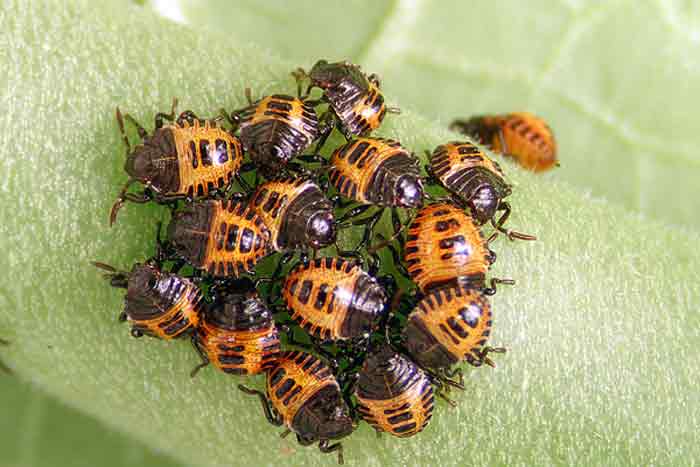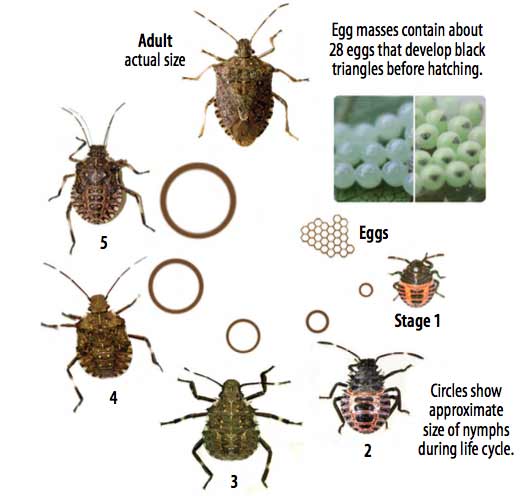Stink bugs are of different species with different reproductive life cycles. However, they pass through the same stages of growth and development. When referring to the life cycle of the stink bug it is important to consider the following:
- The type of life cycle
- The process through which they reproduce
- The morphological changes to the eggs and nymphs
- The adults morphology
When stink bugs have hibernated during the early spring, they return ready to mate and populate. The female and male stink bugs attract each other through vibrational frequencies by rubbing their feet and wings against each other. They then mate when the female is in the oviposition about 2 weeks in the start of spring.
Stink bugs have a general reproductive cycle that follows through the egg stage, the nymphal instars and eventually the adult stage.
This type of metamorphosis is known as hemimetabolous since they do not have a resting stage as in other insects that are holometabolous. Therefore, stink bugs have the nymphal stages in place of the pupal and the larval stages.
The nymphs are wingless and are supposed to complete 5 instars of growth and development before they can become adults. During the instars, they molt to allow for growth.
Stink bugs bear minimal differences in the way the eggs and the instars look like in morphology. This depends on their species. There are also differences in the way the eggs are clustered when laid.
The life span of stink bugs also differs between species in the face of different environmental conditions among other factors but tend to be inclined towards 50 days to about 8 months.
They are able to hibernate at a point in their life especially when there are adverse conditions that do not support their livelihood.
During winter, for instance, they need to get a warmer place and enter a hibernative stage known as diapause then re-emerge during the spring.
Table of Contents
Eggs
The eggs are produced by the female after mating. The female stink bugs are able to lay eggs more than once in a day and upto 5 times in a day.
In fact, one interesting thing is that the females are able to store sperms to suffice their fertilization for eggs laid in its lifespan. The normally hatch in a period of about 4 to 5 days.
The eggs are normally laid on a plant leaf and are clustered together forming aggregates. Aggregates bear different numbers of eggs depending on the species of the stink bug.
On average, the eggs are clustered in about 20 to 150 eggs. For instance, the brown marmorated stink bug lays eggs in clusters of 25, the Red-banded Stink Bug, 30, and the southern green stink bug, 150. They are organized in rows too.
The color of the eggs also differ with the species of the stink bugs. In the Painted Bagrada Stink Bug, the eggs are white when deposited but later turn pink on maturing. The brown marmorated stink bugs have eggs that are white and may range from this to green.
The Red-banded Stink Bug has eggs that are dark red in color but may have some brown in place of red. They have a white band around the edge of the egg.
Baby stink Bugs (Nymphs)
Talking of insects such as stink bugs and the like of the hoppers which fall in the same category, the immediate life form during the reproductive cycle is the ‘nymph’.
The reason this is so, is due to the fact that stink bugs undergo what is known as hemimetabolous or gradual metamorphosis while other insects such as the butterfly have a larvae followed by a pupae stage meaning they are holometabolous or undergo complete metamorphosis.
The stink bug’s babies are similar in morphology to the adult form and the difference only sets in when you consider the color and the size among other characteristics around the neck, on the head or the scrutellum.
To add, the nymphs of stink bugs undergo molting stages that are known as instars.
Therefore, the nymph form of a stink bug differs from one stink bug to the other as they fall into different sub-families, genus and species all together. For instance:
- The Green Stink Bug has early instars with nymphs that are black embossed with orange markings. Later on, they become black with a green head and the abdomen therefore assumes a green color with some spots of black. The adults are green with dark bands on the antennae.
- The Southern Green Stink Bugs have nymphs that are brown or dark brown in the early stages while as they age, they become green with some white spots on the scrutellum. The adults are brown in a mottled fashion with some green and red on the antennae.
- The Brown Marmorated Stink Bug has early nymphs that are dark in color on the head and the pronotum. Unlike the adults that have dark and white on the sides of the abdomen, the early nymphs are greeted with and orange and red specked with some black striping on the edges of the abdomen.
The comparison between the nymphs and the adults in stink bugs cannot be exhausted and this article just picks a few of them that are the commonest.
Female & Male Adults
Stink bugs, whether females of males, can be differentiated with consideration of the size, spots and the genitalia.
Size: you can take mature stink bugs and observe for their differences of size side by side.
They might look the same in size, probably an average of ¾ of an inch in length, but the female is much smaller.
However, the best way to tell the difference is always the reproductive system. It is more beneficial to have a number of bed bugs in this comparison to make a more objective difference.
Spots: this can be particularly used in telling the difference between the males and females of the brown marmorated stink bug.
In this type of stink bug, there is normally a dark band that crosses the scrutellum which might be used to distinguish the two.
In males, you will see a raise in the bumps along this band while in females they are flat and therefore smooth.
Potential mates attract each other by the use of a pheromone and by rubbing their legs and wings to makes some noise that attracts other stink bugs of the opposite sex.
These are known as vibrational signals and it has been purported by Polainar and Jerne et al. (2016) that the potential mate uses the same vibrational mechanism to answer.
Life Span-how Long do stink bugs live?
Since there are different species of stink bugs, the lifespan may also vary.
Therefore, this article will take an ideal stink bug, which is the most common of all the stink bugs; the brown marmorated stink bug.
This stink bug is able to live for as long as 6 months and can extend into the 8th and 10th month.
According to Terminix Inc., there are stink bugs that have a really short life span such as the Conchuela Stink Bug. They have a 70-day life span.
However, researchers tend to believe that there are factors that could account for a variation of the lifespans between different species and even between members of the same species such as:
- The availability of food to suffice the growth and development of instars. If food is not in plenty, then, just like all other animals, they will have short lifespans. Even despite the fact that they can hibernate.
- Availability of a place to hibernate is necessary for their survival. Otherwise, they will succumb to the adverse conditions.
Therefore, it is not pre-determined that stink bugs would live for a certain length of time as there are factors that are involved. To add, life expectancies are calculated based on an average and may not apply to an individual stink bug.
Stink bug metamorphosis
Metamorphosis refers to a process through which an animal grows and develops with expected changes or increase in the complexity of its morphology which is its physical make-up.
This biological process begins after birth or hatching. In the case of stink bugs, they lay eggs and therefore morphology begins after the eggs are hatched.
Growth and development of increase in this complexity occurs due to differentiation of different cells into more specialized cells that function differently and located in different parts of the body of the stink bug.
There are three types of metamorphosis including ametaboly, hemimetaboly and holometaboly. Ametaboly refers to growth that involves very little difference when comparing the larvae and the adult forms.
Hemimetabolous as well as holometabolous insects exhibit significant changes or differences between their younger and adult forms.
However, the holometabolous type involves a resting stage known as a pupae during which the worm-form of the insect is enclosed in a cocoon and occurs between the larval and the adult stages.
Since this does not happen in stink bugs, then you can say this confidently; that stink bugs are hemimetabolous as they pass through a nymphal stage with instars and molting as they increase in size and color or other changes in morphology to the adult.
In summary, it is therefore a ‘egg-nymphal instars-adult’ cycle.
Why do stink bugs hibernate?
Yes, stink bugs do hibernate. They go through a hibernation known as ‘diapause’. In this hibernation form, they spontaneously interrupt their growth and development. This is in response to:
- Adverse environmental conditions such as the winter weather during which it is too cold for insects to survive. They therefore enter your homes and find some solace in the warmth. You are most likely to find them hidden in the cracks and crevices of your walls then emerge during the spring.
- Short-term changes in food availability, temperature and weather.
It happens in certain animals and not in all. It does happen in stink bugs. If stink bugs were holometabolous, they would have had a hibernative stage in which they are encased in a cocoon. During this stage;
- There is a remarkable reduction of suppression in the metabolic activity of stink bugs so that they are able to survive on very little food. Energy expended is therefore minimal.
- The female stink bugs do not reproduce during the diapause as they require sufficient nutrition in their foods to enable proper growth and development of the eggs and nymphs.
- There is a suspension on general growth and development.
Further Reading
- Facts About Stink Bugs: Types, Where they come from and Frequently Asked Questions(FAQs)
- What does a Stink Bug look like: Pictures & Look-alikes
- What Do Stink Bugs Smell Like & Why
- What do Stink Bugs Eat-How long can they Stay without Food
- Do Stink Bugs Bite? Are they harmful/Poisonous to Pets & Humans?
- How to Get Rid of Stink Bugs-Kill, Repel & Deter Tips
- Stink Bug Traps-Homemade DIY,How to Make & Reviews



